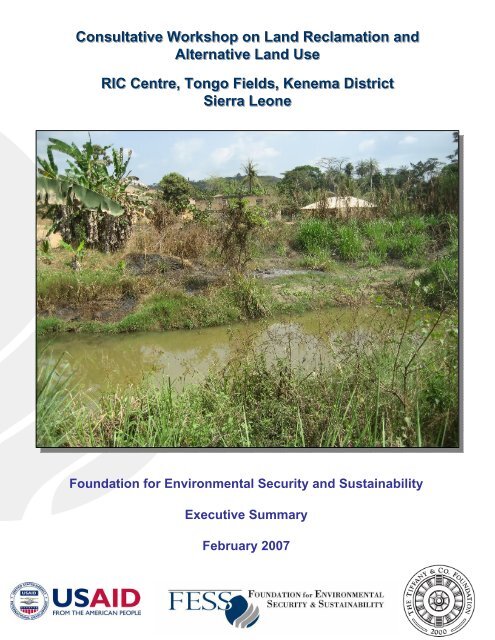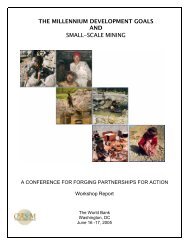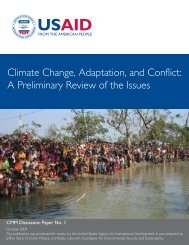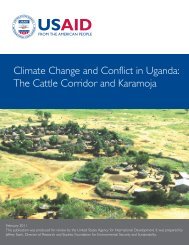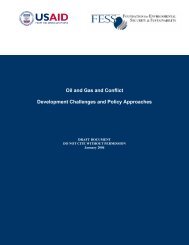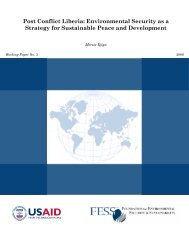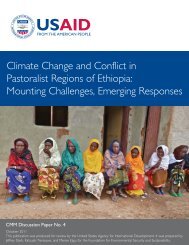Consultative Workshop on Land Reclamation and Alternative Land ...
Consultative Workshop on Land Reclamation and Alternative Land ...
Consultative Workshop on Land Reclamation and Alternative Land ...
You also want an ePaper? Increase the reach of your titles
YUMPU automatically turns print PDFs into web optimized ePapers that Google loves.
The Foundati<strong>on</strong> for Envir<strong>on</strong>mental Security <strong>and</strong> Sustainability (FESS) is a public policyfoundati<strong>on</strong> established to advance knowledge <strong>and</strong> provide effective soluti<strong>on</strong>s to keyenvir<strong>on</strong>mental security c<strong>on</strong>cerns around the world. FESS c<strong>on</strong>ducts extensive field research incombinati<strong>on</strong> with data analysis to produce policy-oriented reports <strong>and</strong> recommendati<strong>on</strong>s thataddress envir<strong>on</strong>mental risks to stability.President: Ray Simm<strong>on</strong>sExecutive Director: Darci Glass-RoyalThis report was produced in 2007 by the Foundati<strong>on</strong> for Envir<strong>on</strong>mental Security <strong>and</strong>Sustainability. The report was prepared by principal writer, Estelle Levin, in collaborati<strong>on</strong> withEllen Suthers <strong>and</strong> with editorial assistance from Kelley Lubovich.Cover photo: Jeffrey Stark. Artisanal mining pits in Ngiehun, Lower Bambara Chiefdom,Kenema District, Sierra Le<strong>on</strong>e.AcknowledgementFESS would like to thank the Tiffany & Co. Foundati<strong>on</strong> <strong>and</strong> the U.S. Agency for Internati<strong>on</strong>alDevelopment for their generous support.
ACRONYMSDACDFFESSGOSLIDMPLBMCLBYCMAFSMMRMWDPNADASWDPUSAIDDiam<strong>on</strong>d Area Community Development FundFoundati<strong>on</strong> for Envir<strong>on</strong>mental Security <strong>and</strong> SustainabilityGovernment of Sierra Le<strong>on</strong>eIntegrated Diam<strong>on</strong>d Management ProgramLower Bambara Mining CommitteeLower Bambara Youth Coaliti<strong>on</strong>Ministry of Agriculture <strong>and</strong> Food SecurityMinistry of Mineral ResourcesMuloma Women’s Development ProjectNgoyielahindeh Agriculture Development Associati<strong>on</strong>Sinava Women’s Development ProjectUnited States Agency for Internati<strong>on</strong>al Development1
EXECUTIVE SUMMARYINTRODUCTIONT<strong>on</strong>go Fields is the sec<strong>on</strong>d largest diam<strong>on</strong>d-producing area in Sierra Le<strong>on</strong>e. Endowed with both alluvial<strong>and</strong> kimberlite deposits, T<strong>on</strong>go Fields became a major hub of artisanal diam<strong>on</strong>d mining during <strong>and</strong> after theperiod of c<strong>on</strong>flict from about 1999 to 2002. T<strong>on</strong>go Fields is the urban center of the Lower BambaraChiefdom, <strong>on</strong>e of sixteen chiefdoms in the Kenema district <strong>and</strong> home to approximately 78,000 people. Theissue of l<strong>and</strong> reclamati<strong>on</strong> is a timely <strong>on</strong>e in this regi<strong>on</strong>. Acres of l<strong>and</strong> in the T<strong>on</strong>go Fields area have beenmined extensively, <strong>and</strong> many mined sites now are virtually unproductive, hazardous to community health<strong>and</strong> safety, <strong>and</strong> a waste of potentially arable l<strong>and</strong>. There is local awareness of the need for envir<strong>on</strong>mentalreclamati<strong>on</strong>, <strong>and</strong> there are already precedents within the Lower Bambara Chiefdom for reclaiming minedl<strong>and</strong> <strong>and</strong> planting food crops.The Foundati<strong>on</strong> for Envir<strong>on</strong>mental Security <strong>and</strong> Sustainability (FESS) is a public policy organizati<strong>on</strong> thatworks with governments, civil society organizati<strong>on</strong>s, <strong>and</strong> internati<strong>on</strong>al d<strong>on</strong>or organizati<strong>on</strong>s to addressenvir<strong>on</strong>mental issues that have implicati<strong>on</strong>s for political stability, social peace, livelihoods, <strong>and</strong> sustainabledevelopment. Supported by a grant from the Tiffany & Co. Foundati<strong>on</strong>’s Envir<strong>on</strong>ment Program <strong>and</strong> corefunding from the U.S. Agency for Internati<strong>on</strong>al Development (USAID), FESS is initiating a project to workwith diam<strong>on</strong>d mining communities in Sierra Le<strong>on</strong>e to improve envir<strong>on</strong>mental c<strong>on</strong>diti<strong>on</strong>s after mining <strong>and</strong> toincrease livelihood opportunities. A primary objective of the project is to establish <strong>on</strong>e or moredem<strong>on</strong>strati<strong>on</strong> sites to serve as models of effective <strong>and</strong> sustainable l<strong>and</strong> reclamati<strong>on</strong>. The overall goal is todefine <strong>and</strong> implement a process for c<strong>on</strong>ducting envir<strong>on</strong>mental reclamati<strong>on</strong> <strong>and</strong> establishing alternative usesfor mined-out l<strong>and</strong> that may be replicated throughout Sierra Le<strong>on</strong>e <strong>and</strong> implemented in other alluvialdiam<strong>on</strong>d mining communities in Africa.In the interest of initiating a community-based, participatory project <strong>on</strong> l<strong>and</strong> reclamati<strong>on</strong>, FESS has beenworking to develop a body of knowledge about Sierra Le<strong>on</strong>ean diam<strong>on</strong>d mining communities <strong>and</strong> anunderst<strong>and</strong>ing of local orientati<strong>on</strong>s toward l<strong>and</strong> reclamati<strong>on</strong>. Between November 2006 <strong>and</strong> February 2007,FESS held a series of c<strong>on</strong>sultative meetings with nati<strong>on</strong>al <strong>and</strong> local leaders in Freetown <strong>and</strong> in the K<strong>on</strong>o <strong>and</strong>Kenema districts to discuss l<strong>and</strong> remediati<strong>on</strong> <strong>and</strong> explore possibilities for implementing a project. Throughthese discussi<strong>on</strong>s, it became clear that in order to have an effective <strong>and</strong> sustainable l<strong>and</strong> reclamati<strong>on</strong> project,there must be shared underst<strong>and</strong>ing <strong>and</strong> commitments from all stakeholders <strong>and</strong> broad-based support fromwithin the communities at large.In February, 2007, FESS c<strong>on</strong>ducted multistakeholder workshops in T<strong>on</strong>go Fields, Kenema district (February10–11, 2007) <strong>and</strong> in Koidu, K<strong>on</strong>o district (February 8–9, 2007) to assess the interest in <strong>and</strong> feasibility ofimplementing a l<strong>and</strong> reclamati<strong>on</strong> project in these areas. Each of the workshops included approximately 45invited participants who represented a range of stakeholder groups. The compositi<strong>on</strong> of the workshop inT<strong>on</strong>go Fields was somewhat different from that in Koidu, since the former community is comprised of asingle chiefdom, Lower Bambara, <strong>and</strong> the latter is comprised of several chiefdoms. This is <strong>on</strong>e factor thataccounts for the two workshops taking <strong>on</strong> different characters while the program agendas were essentiallythe same. Another factor is that the facilitators made a few adjustments in the structuring of activities inT<strong>on</strong>go Fields, based <strong>on</strong> less<strong>on</strong>s learned from the Koidu workshop. The objectives of the sessi<strong>on</strong>s remainedthe same for each workshop. In T<strong>on</strong>go Fields, the workshop was c<strong>on</strong>ducted in Krio, with M<strong>and</strong>e <strong>and</strong>English translati<strong>on</strong>s for clarificati<strong>on</strong> when necessary, whereas in Koidu, the workshop was c<strong>on</strong>ducted inKrio <strong>and</strong> English. To ensure that each report is relevant to the respective workshop participants, as well asto provide the opportunity to compare outcomes, each workshop report is published as a separate document.Each workshop c<strong>on</strong>sisted of two full days of plenary <strong>and</strong> small-group discussi<strong>on</strong>s. Participants shared ideas<strong>and</strong> negotiated differences of opini<strong>on</strong> as they worked to build a comm<strong>on</strong> underst<strong>and</strong>ing of what l<strong>and</strong>2
eclamati<strong>on</strong> might mean for their communities <strong>and</strong> what would be required of the various stakeholders for al<strong>and</strong> reclamati<strong>on</strong> initiative to be successful. The workshop facilitati<strong>on</strong> methods aided in the process ofc<strong>on</strong>sensus building, where checking <strong>and</strong> rechecking at incremental points in the program ensured that whatwas reported <strong>and</strong> officially recorded did, in fact, reflect fully <strong>and</strong> accurately the c<strong>on</strong>tributi<strong>on</strong>s thatindividuals made in the various discussi<strong>on</strong>s. In this manner, an atmosphere of trust <strong>and</strong> cooperati<strong>on</strong> wasdeveloped such that by the end of each workshop, representatives of the various stakeholder groups cameforward freely to make <strong>and</strong> sign detailed commitments <strong>on</strong> behalf of their c<strong>on</strong>stituencies in support of l<strong>and</strong>reclamati<strong>on</strong> in their communities. The workshops not <strong>on</strong>ly served as exercises in project planning, but alsoc<strong>on</strong>tributed to building experience in community decisi<strong>on</strong>-making al<strong>on</strong>g the lines of democratic principles.This is a significant achievement <strong>and</strong> a str<strong>on</strong>g first step in the implementati<strong>on</strong> of a project intended toreclaim mined-out l<strong>and</strong> through broad-based community support <strong>and</strong> participati<strong>on</strong> for the benefit of thecommunity as a whole.In the interest of accurate reporting in this executive summary as well as the full report of the workshop, thetext retains titles used by participants to refer to ministries associated with issues of l<strong>and</strong> <strong>and</strong> envir<strong>on</strong>ment.In some instances, these titles are either outdated or <strong>on</strong>ly partially correct. The instituti<strong>on</strong>s whose functi<strong>on</strong>sare relevant to l<strong>and</strong> reclamati<strong>on</strong> include the Ministry of <strong>L<strong>and</strong></strong> <strong>and</strong> Country Planning <strong>and</strong> the Nati<strong>on</strong>alCommissi<strong>on</strong> for the Envir<strong>on</strong>ment <strong>and</strong> Forestry, the result of a recent reorganizati<strong>on</strong>.The workshop program is attached as Appendix I; the participant list is attached as Appendix II; <strong>and</strong> thedocument of formal commitments made by community leaders in support of l<strong>and</strong> reclamati<strong>on</strong> is attached asAppendix III.TONGO FIELDS WORKSHOPThe T<strong>on</strong>go Fields workshop participants represented a broad base of stakeholder groups including: LowerBambara secti<strong>on</strong> chiefs <strong>and</strong> their representatives, the Lower Bambara Mining Committee, the KenemaDistrict Council, l<strong>and</strong>owner families, two women’s development associati<strong>on</strong>s, an agriculture developmentassociati<strong>on</strong>, youth associati<strong>on</strong>s, a farmer’s associati<strong>on</strong>, the Integrated Diam<strong>on</strong>d Development Program(USAID), <strong>and</strong> an internati<strong>on</strong>al d<strong>on</strong>or agency. The workshop was structured to meet a series of objectivesthat worked toward the goal of having representatives from the group of participants identify <strong>and</strong> formallyacknowledge their various degrees of commitment <strong>and</strong> support for a project of l<strong>and</strong> remediati<strong>on</strong> in theircommunities.Objective One: To develop a comm<strong>on</strong> underst<strong>and</strong>ing of the c<strong>on</strong>cept of l<strong>and</strong> reclamati<strong>on</strong> <strong>and</strong> c<strong>on</strong>siderits importance to the community.When asked in a plenary sessi<strong>on</strong> to share their percepti<strong>on</strong>s about the meaning of l<strong>and</strong> reclamati<strong>on</strong>, T<strong>on</strong>goFields participants generally agreed <strong>on</strong> the c<strong>on</strong>cept of l<strong>and</strong> reclamati<strong>on</strong> as a process for returning the l<strong>and</strong> toa more productive state in order to achieve food security, sustainability, <strong>and</strong> envir<strong>on</strong>mental protecti<strong>on</strong>. <strong>L<strong>and</strong></strong>reclamati<strong>on</strong> also was seen as something that can provide opportunities for youth <strong>and</strong> thus prevent outmigrati<strong>on</strong>.To gauge the level of importance attached to l<strong>and</strong> reclamati<strong>on</strong> in the Lower Bambara Chiefdom <strong>and</strong> toincrease underst<strong>and</strong>ing of the ways in which the community may be positively or negatively disposedtoward reclaiming mined l<strong>and</strong>, the facilitator asked the group: 1) What does the term “l<strong>and</strong> reclamati<strong>on</strong>”mean to you?, 2) What do you see as positive <strong>and</strong> negative incentives for doing l<strong>and</strong> reclamati<strong>on</strong>?, <strong>and</strong> 3)What might be the c<strong>on</strong>sequences of not doing l<strong>and</strong> reclamati<strong>on</strong>? Participants resp<strong>on</strong>ded with <strong>on</strong>ly positiveresp<strong>on</strong>ses, saying:3
Benefits of l<strong>and</strong> reclamati<strong>on</strong> are that it may• Make the l<strong>and</strong> useful, especially for agricultural <strong>and</strong> recreati<strong>on</strong>al activities.• Remove some of the health hazards that the mining l<strong>and</strong>scape can produce.• Bring attenti<strong>on</strong> to the issue of access to clean water in the community.One participant menti<strong>on</strong>ed the importance of c<strong>on</strong>sidering the spiritual dimensi<strong>on</strong> in that destroying l<strong>and</strong> willbring retaliati<strong>on</strong> from God unless the l<strong>and</strong> is reclaimed.Objective Two: To identify the challenges of l<strong>and</strong> reclamati<strong>on</strong> in alluvial diam<strong>on</strong>d miningcommunities.In small-group discussi<strong>on</strong>s, participants identified various challenges associated with l<strong>and</strong> reclamati<strong>on</strong>according to five categories: political/structural, ec<strong>on</strong>omic, social, cultural, <strong>and</strong> technical. Each group wasasked to take <strong>on</strong>e of the categories <strong>and</strong> identify four or five most important challenges they c<strong>on</strong>sidered tofall within that category. This instructi<strong>on</strong> was incorporated into the T<strong>on</strong>go Fields workshop to help focusthe discussi<strong>on</strong>s <strong>and</strong> leave more time than was available in the Koidu workshop for discussi<strong>on</strong> of soluti<strong>on</strong>s tothe challenges. After each small-group report, there was a short period for discussi<strong>on</strong> am<strong>on</strong>gst all of theworkshop participants. The resp<strong>on</strong>ses were as follows:Political challengesThe main political challenges participants menti<strong>on</strong>ed were: marginalizati<strong>on</strong>, nepotism, selfishness <strong>and</strong>greed, misinformati<strong>on</strong>, lack of political will, <strong>and</strong> interference of regi<strong>on</strong>al or nati<strong>on</strong>al politics in local issues.Ec<strong>on</strong>omic challengesOne ec<strong>on</strong>omic challenge identified by participants was the risk that reclamati<strong>on</strong> will deprive certain groupsof benefits they receive from the l<strong>and</strong> in its current state. For example, reclamati<strong>on</strong> could prevent minersfrom getting an income or dispossess a l<strong>and</strong>owning family in order to allocate the l<strong>and</strong> to the community. Itwas noted that there is a need to prepare the l<strong>and</strong> appropriately so that it can be as productive as possible inits alternative use; for example, through the use of fertilizer. A key ec<strong>on</strong>omic challenge menti<strong>on</strong>ed was theneed to find the finances to do the reclamati<strong>on</strong>.Social challengesParticipants identified the main social issue as a lack of comm<strong>on</strong> interests. For example, they menti<strong>on</strong>ed thecompeting interests between the chiefs <strong>and</strong> youths <strong>and</strong> a lack of faith am<strong>on</strong>gst youths that they wouldbenefit from l<strong>and</strong> reclamati<strong>on</strong>.Cultural challengesThe main cultural challenges centered <strong>on</strong> secret society requirements <strong>and</strong> customs of l<strong>and</strong> ownership in theLower Bambara chiefdom. One challenge menti<strong>on</strong>ed was the inability of secret society members toparticipate in reclamati<strong>on</strong> because of the dem<strong>and</strong>s owing to initiati<strong>on</strong> cerem<strong>on</strong>ies. Another was the need todo complex cultural cerem<strong>on</strong>ies to purify certain l<strong>and</strong> before reclamati<strong>on</strong> could proceed. Given theinclusive nature of the Mende system of l<strong>and</strong>-ownership, it may take a l<strong>on</strong>g time to c<strong>on</strong>sult all of therelevant members of the l<strong>and</strong>owning family. It may also be necessary to revisit historical agreements madebetween l<strong>and</strong>owners <strong>and</strong> companies.4
Technical challengesParticipants highlighted knowledge as a key technical challenge, as well as planning, the availability of tools<strong>and</strong> equipment, <strong>and</strong> the threat of natural hazards during operati<strong>on</strong>s.Objective Three: To develop soluti<strong>on</strong>s for addressing the challenges of l<strong>and</strong> reclamati<strong>on</strong>.After having identified sets of challenges associated with l<strong>and</strong> reclamati<strong>on</strong>, participants re-joined their smallgroups to exchange ideas about possible soluti<strong>on</strong>s to the challenges. Each of the small groups reported theirperspectives in a plenary sessi<strong>on</strong> for further discussi<strong>on</strong>.The main c<strong>on</strong>clusi<strong>on</strong> from these discussi<strong>on</strong>s was that there are a number of things any organizati<strong>on</strong>attempting to engage in l<strong>and</strong> reclamati<strong>on</strong> should do to ensure a successful outcome. Participants proposedthat an organizati<strong>on</strong> such as FESS should:• Carry out comprehensive fact-finding activities.• Document decisi<strong>on</strong>s <strong>and</strong> agreements.• Hold sensitizati<strong>on</strong> meetings.• Encourage transparency, h<strong>on</strong>esty, <strong>and</strong> accountability.• Ensure community members have equal access to the benefits that accrue from the reclamati<strong>on</strong> <strong>and</strong>from the newly established alternative use of the l<strong>and</strong>.• C<strong>on</strong>tract competent local companies to do the reclamati<strong>on</strong>, ensuring that they employ <strong>and</strong> train localyouths to do the work.• Be mindful of nati<strong>on</strong>al <strong>and</strong> regi<strong>on</strong>al politics.• Make the intended alternative l<strong>and</strong> use attractive to the community.• Engage people with the appropriate technical expertise to do the reclamati<strong>on</strong> <strong>and</strong> plan thealternative l<strong>and</strong> use well.Objective Four: To define a process whereby alluvial diam<strong>on</strong>d mining communities may go aboutidentifying l<strong>and</strong> for reclamati<strong>on</strong>.Participants r<strong>and</strong>omly assigned to four groups were asked to c<strong>on</strong>sider how l<strong>and</strong> could be identified forreclamati<strong>on</strong>, by what actors taking what resp<strong>on</strong>sibilities, <strong>and</strong> through what steps in a process. The results ofthese discussi<strong>on</strong>s, shared in a plenary sessi<strong>on</strong>, were as follows:Indicators that l<strong>and</strong> is mined-out <strong>and</strong> suitable for reclamati<strong>on</strong>• Evidence of expanses of bedrock <strong>and</strong>/or piles of exhausted gravel.• Destructi<strong>on</strong> of vegetati<strong>on</strong>.• An unusual topography with the presence of many pits, piles of overburden, <strong>and</strong> lakes.• Depopulati<strong>on</strong> of the mining area <strong>and</strong> a decrease in or absence of mining activities.• Existence of other activities such as agriculture in the area.• Unwillingness of miners to mine the area.• C<strong>on</strong>sensus am<strong>on</strong>g the l<strong>and</strong>owners, youth, diggers, <strong>and</strong> miners that the l<strong>and</strong> is mined -out.Key actors involved in identifying the l<strong>and</strong>• Miners.• <strong>L<strong>and</strong></strong>owners.5
• Chiefdom Council (which includes the paramount chief, town chief, secti<strong>on</strong> chief, chiefdomspeaker, chiefdom mining committee, youth leader, women’s leader, treasury clerk, <strong>and</strong> wardrepresentative).• Local councillors.• Central Government representatives, especially the Ministry of Mineral Resources (MMR), theMinistry of Agriculture <strong>and</strong> Food Security (MAFS), <strong>and</strong> the Ministry of <strong>L<strong>and</strong></strong>s <strong>and</strong> RuralDevelopment.Resp<strong>on</strong>sibilities <strong>and</strong>/or c<strong>on</strong>tributi<strong>on</strong>s of the key actors <strong>and</strong> others• Chiefs identify mined-out areas <strong>and</strong> the relevant l<strong>and</strong>owning family; ensure protecti<strong>on</strong> of thereclaimed l<strong>and</strong> from any encroachment for example, by forming <strong>and</strong> enforcing bylaws; <strong>and</strong> endorsethe documentati<strong>on</strong> signed by the l<strong>and</strong>owner.• Councillors endorse the documentati<strong>on</strong> signed by the l<strong>and</strong>owner.• The l<strong>and</strong>owning family identifies l<strong>and</strong> for reclamati<strong>on</strong>, gives their approval (or not) for the l<strong>and</strong> tobe reclaimed, ensures that no further mining activities take place, <strong>and</strong> signs the documentati<strong>on</strong> thatrecords the decisi<strong>on</strong>s <strong>on</strong> reclamati<strong>on</strong>.• Central government representatives from the MMR <strong>and</strong> Ministry of <strong>L<strong>and</strong></strong>s <strong>and</strong> Rural Developmentc<strong>on</strong>firm that the l<strong>and</strong> has not been allocated to any other organizati<strong>on</strong> for some other purpose. TheMMR helps identify l<strong>and</strong> for reclamati<strong>on</strong>. The Ministry of <strong>L<strong>and</strong></strong>s <strong>and</strong> Rural Development measuresthe l<strong>and</strong> <strong>and</strong> prepares documentati<strong>on</strong>.• Youths provide the labor for doing the reclamati<strong>on</strong> <strong>and</strong> are involved in deciding which l<strong>and</strong> shouldbe reclaimed through their representative, who serves <strong>on</strong> the Chiefdom Council.• Miners <strong>and</strong> diggers identify mined-out areas, either by their activities or through c<strong>on</strong>sultati<strong>on</strong>.• D<strong>on</strong>ors provide financial assistance.Step-by-step process to obtain l<strong>and</strong> for reclamati<strong>on</strong>• Meet with central government.• Make courtesy calls to the chiefdom authorities, starting with the town chief if you know which l<strong>and</strong>you would like to reclaim, or the paramount chief if you have yet to identify a potential site.• Make a courtesy call to the head of the l<strong>and</strong>owning family.• Hold a community c<strong>on</strong>sultati<strong>on</strong> to get approval for reclaiming a particular site <strong>and</strong> to identifydesirable uses for the l<strong>and</strong> after reclamati<strong>on</strong>.• Arrange documentati<strong>on</strong> to be signed by key actors (the town chief, l<strong>and</strong>owner, <strong>and</strong> NGOs).• Organize funding.• Organize labor.• Begin reclamati<strong>on</strong>.• Administer, supervise, <strong>and</strong> m<strong>on</strong>itor through the community <strong>and</strong> the field manager.Objective Five: To solicit community input into other ec<strong>on</strong>omically viable uses of l<strong>and</strong> in alluvialdiam<strong>on</strong>d mining communities.Given the key role of l<strong>and</strong>owning families al<strong>on</strong>gside that of the chiefs in the system of l<strong>and</strong> ownership in theLower Bambara Chiefdom, the discussi<strong>on</strong>s in the T<strong>on</strong>go Fields workshop had a somewhat differentcharacter than in Koidu, where the l<strong>and</strong> is held in comm<strong>on</strong> <strong>and</strong> the chiefs have final authority as to itsdispositi<strong>on</strong>.After having defined a process for identifying l<strong>and</strong> for remediati<strong>on</strong>, participants were divided into threegroups: <strong>on</strong>e to define a process for carrying out l<strong>and</strong> reclamati<strong>on</strong>; the sec<strong>on</strong>d to identify those people who6
would have key roles in deciding how l<strong>and</strong> after reclamati<strong>on</strong> would be used; <strong>and</strong> the third to engage indiscussi<strong>on</strong> about what alternative uses could actually be implemented <strong>on</strong> reclaimed l<strong>and</strong> in the LowerBambara Chiefdom areas. The group reports <strong>and</strong> plenary discussi<strong>on</strong> elicited the following points:Mechanics of l<strong>and</strong> reclamati<strong>on</strong>• Find sources of funding (d<strong>on</strong>ors, government, MMR).• C<strong>on</strong>sult the community.• Plan the reclamati<strong>on</strong> (including hiring laborers).• Do the rehabilitati<strong>on</strong>.Key decisi<strong>on</strong>-makers for how l<strong>and</strong> reclamati<strong>on</strong> proceeds• Youths, who provide the labor force.• Chiefs, who supervise the work, maintain law <strong>and</strong> order, <strong>and</strong> ensure people do not misuse thereclaimed l<strong>and</strong>.• <strong>L<strong>and</strong></strong>owners, who know the l<strong>and</strong>scape, demarcate the boundaries, <strong>and</strong> sign documentati<strong>on</strong>.• D<strong>on</strong>ors, who give funding <strong>and</strong> do m<strong>on</strong>itoring.• Government, which also does funding <strong>and</strong> does m<strong>on</strong>itoring.• The reclamati<strong>on</strong> should involve local people as much as possible.Types of material resources required• Shovels, wheelbarrows, pick-axes, cutlasses, <strong>and</strong> power saws for manual labor.• Caterpillars, bulldozers, <strong>and</strong> other heavy equipment for mechanized reclamati<strong>on</strong>.• Finance to pay laborers.• Other materials including water pumps, petrol, raincoats, rain boots, h<strong>and</strong> gloves, <strong>and</strong> medicines (ifthe work is d<strong>on</strong>e in the rainy seas<strong>on</strong>).• Food.• Pesticides to kill leaches <strong>and</strong> snakes.• Stati<strong>on</strong>ery <strong>and</strong> office materials.Key decisi<strong>on</strong>-makers for how to use the l<strong>and</strong> after reclamati<strong>on</strong>• Authorities (chiefs, youth, <strong>and</strong> women leaders).• <strong>L<strong>and</strong></strong>owners.• People with technical expertise relevant to implementing the reclamati<strong>on</strong> <strong>and</strong> the alternative use forthe l<strong>and</strong>.Uses for reclaimed l<strong>and</strong>• Ec<strong>on</strong>omic: Agricultural uses, including rice cultivati<strong>on</strong>, cash crop farming, vegetable gardening,fish farming, <strong>and</strong> livestock rearing.• Social: C<strong>on</strong>structi<strong>on</strong> of a guesthouse, school, community center, or recreati<strong>on</strong>al center.Participants in the T<strong>on</strong>go Fields workshop engaged in an extended discussi<strong>on</strong> <strong>on</strong> the subject of managingthe benefits from reclamati<strong>on</strong> <strong>and</strong> distributing them between the l<strong>and</strong>owning family <strong>and</strong> the community. Anumber of different models for sharing the benefits were suggested. However, the facilitator stated that, ifFESS were to initiate a l<strong>and</strong> reclamati<strong>on</strong> project in the Lower Bambara Chiefdom, the issue of beneficiati<strong>on</strong>7
would be clarified <strong>on</strong> a case-by-case basis through negotiati<strong>on</strong>s between the community <strong>and</strong> the relevantl<strong>and</strong>owning family or families, <strong>on</strong>ce an actual site <strong>and</strong> end-use was chosen.In order to ensure that it is actually the targeted beneficiaries who benefit, the third group of discussantssuggested that it be agreed that the l<strong>and</strong> is to benefit the community, not individuals, <strong>and</strong> that thel<strong>and</strong>owning family <strong>and</strong> any people who had been farming the mined-out l<strong>and</strong> should be compensated insome way for allowing the l<strong>and</strong> to be reclaimed. The group was also mindful of the potential for funders toseek the return of funds at a later date or to seek to benefit from the use(s) to which the l<strong>and</strong> was put afterreclamati<strong>on</strong>. The role of d<strong>on</strong>ors was seen as <strong>on</strong>e of m<strong>on</strong>itoring the use of funds.Objective Six: To determine the commitment of alluvial diam<strong>on</strong>d mining communities to l<strong>and</strong>reclamati<strong>on</strong> <strong>and</strong> alternative l<strong>and</strong> use practices.Two to three leaders from each of several community-based stakeholder groups (secti<strong>on</strong> chiefs, women,youths, l<strong>and</strong>owners, members of the Lower Bambara Chiefdom Mining, <strong>and</strong> district ward councillors) metseparately during Sessi<strong>on</strong> Five of the workshop to discuss <strong>and</strong> reach agreement <strong>on</strong> the commitments theywere willing to make toward reclaiming l<strong>and</strong> in their communities. In the final plenary sessi<strong>on</strong>, the leadersof each group came forward in turn to read aloud the list of commitments they had created <strong>on</strong> behalf of theirrespective stakeholder groups. After members of each group were given an opportunity to make additi<strong>on</strong>sor clarificati<strong>on</strong>s, the floor was opened for comments. Then the workshop facilitator read aloud the finalizedlist of commitments for each group <strong>and</strong> its leaders came forward in turn to sign a commitments document.The T<strong>on</strong>go Fields stakeholder commitments document was signed by seventeen community leaders <strong>on</strong>behalf of six stakeholder groups.CONCLUSIONThe <str<strong>on</strong>g>C<strong>on</strong>sultative</str<strong>on</strong>g> <str<strong>on</strong>g>Workshop</str<strong>on</strong>g> <strong>on</strong> <strong>L<strong>and</strong></strong> Reclamati<strong>on</strong> <strong>and</strong> <strong>Alternative</strong> Use held in T<strong>on</strong>go Fields, KenemaDistrict <strong>on</strong> February 10–11, 2007 engaged about 45 community leaders in a process to c<strong>on</strong>sider what l<strong>and</strong>reclamati<strong>on</strong> means, identify potential benefits of l<strong>and</strong> reclamati<strong>on</strong>, identify challenges <strong>and</strong> possible soluti<strong>on</strong>sfor the challenges associated with l<strong>and</strong> reclamati<strong>on</strong>, define the process for identifying l<strong>and</strong> suitable forreclamati<strong>on</strong> <strong>and</strong> for deciding the future use for the reclaimed l<strong>and</strong>, <strong>and</strong> to build commitments am<strong>on</strong>g thevarious stakeholders to support the reclamati<strong>on</strong> of mined-out l<strong>and</strong> in the Kenema district.The workshop was an exercise in community sensitizati<strong>on</strong> <strong>and</strong> participati<strong>on</strong> in decisi<strong>on</strong>-making aroundplanning for envir<strong>on</strong>mental reclamati<strong>on</strong>. The participants negotiated agreements <strong>on</strong> challenging aspects ofl<strong>and</strong> reclamati<strong>on</strong> as it relates to obtaining <strong>and</strong> sharing informati<strong>on</strong>, l<strong>and</strong> ownership, the role of youths <strong>and</strong>miners, good governance through transparency <strong>and</strong> documentati<strong>on</strong>, equitable beneficiati<strong>on</strong>, <strong>and</strong> the potentialfor l<strong>and</strong> reclamati<strong>on</strong> to bring food security, sustainability, envir<strong>on</strong>mental protecti<strong>on</strong>, <strong>and</strong> development forthe sake of future generati<strong>on</strong>s.The T<strong>on</strong>go Fields workshop provided a process through which community members <strong>and</strong> their leaders <strong>and</strong>team members of FESS reached a comm<strong>on</strong> underst<strong>and</strong>ing of what reclamati<strong>on</strong> of mined-out l<strong>and</strong> wouldinvolve in this area of Sierra Le<strong>on</strong>e. The workshop c<strong>on</strong>stituted an important step in creating politicalbacking for a l<strong>and</strong> reclamati<strong>on</strong> project, as dem<strong>on</strong>strated by the signed commitments made by thestakeholders in the final sessi<strong>on</strong>. The culminati<strong>on</strong> of the workshop in the form of a commitments cerem<strong>on</strong>ywas a clear indicati<strong>on</strong> to the Lower Bambara Chiefdom <strong>and</strong> the FESS team that there is both broad-basedbacking for a l<strong>and</strong> reclamati<strong>on</strong> project <strong>and</strong> an identified mechanism of community cooperati<strong>on</strong> that will helpensure its success as an effective <strong>and</strong> sustainable effort toward improving envir<strong>on</strong>mental c<strong>on</strong>diti<strong>on</strong>s <strong>and</strong>stimulating productive n<strong>on</strong>-mining livelihood activities in the Kenema district.8
APPENDIX I: TONGO FIELDS WORKSHOP PROGRAMDAY 1Opening RemarksTime Activity Pers<strong>on</strong>10:00 – 10:05 Prayer, Welcome, <strong>and</strong> Daniel Gb<strong>on</strong>doIntroducti<strong>on</strong> of Chairman10:05 – 10:10 Opening Remarks – Chairman; Daniel SarmuProject Coordinator, IDMP/PDA/USAID10:10 – 10:15 Statement – Lower BambaraMining CommitteeJames Farma10:15 – 10:20 Statement – FESS Jeffrey Stark10:20 – 10:25 Closing Daniel Gb<strong>on</strong>do<str<strong>on</strong>g>Workshop</str<strong>on</strong>g>10:30 – 11:30 Sessi<strong>on</strong> 1 – Objective 1: Introduce the c<strong>on</strong>cept of l<strong>and</strong> reclamati<strong>on</strong> <strong>and</strong> alternativel<strong>and</strong> use <strong>and</strong> increase knowledge about its importance in alluvial diam<strong>on</strong>d miningcommunities.Ellen Suthers11:30 – 11:45 TEA BREAK11:45 – 13:15 Sessi<strong>on</strong> 2 – Objective 2: Identify problems associated with l<strong>and</strong> reclamati<strong>on</strong> inalluvial diam<strong>on</strong>d mining fields.John Kanu13:15 – 13:45 LUNCH13:45 – 14:15 Sessi<strong>on</strong> 2 (c<strong>on</strong>tinued).John Kanu14:15 – 15:45 Sessi<strong>on</strong> 3 – Objective 3: Develop an integrated approach to addressing thechallenges of l<strong>and</strong> reclamati<strong>on</strong>.John Kanu15:45 – 15:50 BREAK15:50 – 16:30 Sessi<strong>on</strong> 3 (c<strong>on</strong>tinued).16:30 END OF DAY 19
DAY 209:00 – 10:00 Recapitulati<strong>on</strong> of the previous day’s discussi<strong>on</strong>s.Daniel Gb<strong>on</strong>do10:00 – 11:30 Sessi<strong>on</strong> 4 – Objective 4: Provide opportunities for people living in alluvial diam<strong>on</strong>dmining communities to be involved in the process of identifying l<strong>and</strong> forreclamati<strong>on</strong>.Daniel Gb<strong>on</strong>do11:30 – 11:45 TEA BREAK11:45 – 12:15 Sessi<strong>on</strong> 4 (c<strong>on</strong>tinued).Daniel Gb<strong>on</strong>do12:15 – 13:45 Sessi<strong>on</strong> 5 – Objective 5: Solicit community input into other ec<strong>on</strong>omically viableuses of l<strong>and</strong> in alluvial diam<strong>on</strong>d mining communities.Daniel Gb<strong>on</strong>do13:45 – 14:30 LUNCH14:30 – 15:00 Sessi<strong>on</strong> 5 (c<strong>on</strong>tinued).Daniel Gb<strong>on</strong>do15:00 – 16:30 Sessi<strong>on</strong> 6 – Objective 6: Determine the commitment of alluvial diam<strong>on</strong>d miningcommunities to l<strong>and</strong> reclamati<strong>on</strong> <strong>and</strong> alternative l<strong>and</strong> use practice.Daniel Gb<strong>on</strong>do16:30 – 16:35 BREAK16:35 – 17:00 Sessi<strong>on</strong> 6 (c<strong>on</strong>tinued).Daniel Gb<strong>on</strong>do17:00 – 17:15 Recapitulati<strong>on</strong> of workshop <strong>and</strong> closing.Jeffrey Stark, Ellen Suthers, Daniel Gb<strong>on</strong>do10
APPENDIX II: TONGO FIELDS WORKSHOP PARTICIPANTSNo. Name Designati<strong>on</strong> Organisati<strong>on</strong>/Instituti<strong>on</strong>1. Chief Foday M. Bobor Secti<strong>on</strong> ChiefFallay Secti<strong>on</strong>III2. David L. Moiwai Fallay Youth Associati<strong>on</strong>3. Daniel Sarmu Project Coordinator IDMP/PDA/USAID4. Kowah Albert Mani Administrative Officer IDMP/PDA/USAID5. Mary Fofanah Community Mobilizati<strong>on</strong> IDMP/PDA/USAIDOfficer6. Francis K<strong>on</strong>uwa Councillor, Ward 1 Kenema District Council7. Jibao A. Moosa Councillor, Ward 5 Kenema District Council8. Chief Juma Momoh Secti<strong>on</strong> Chief Kojei Ngeiya Secti<strong>on</strong>9. Ibrahim J<strong>on</strong>es Secti<strong>on</strong> Representative Kojei Ngeiyai Secti<strong>on</strong>10. Haja JosephineKoromantyMemberLower Bambara Mining Committee(LBMC)11. James B. Farma Vice Chairman LBMC12. K. B. Gbao Member LBMC13. Nfa Ali Daramy Member LBMC14. Wilfred K. Amara Member LBMC15. Abu F. Brima Lower Bambara Youth Coaliti<strong>on</strong>16. Gibrilla Kamara Lower Bambara Youth Coaliti<strong>on</strong>17. James Balema Samba Chairman Lower Bambara Youth Coaliti<strong>on</strong>18. James C. Fofanah Lower Bambara Youth Coaliti<strong>on</strong>19. Mohamed Fofana Lower Bambara Youth Coaliti<strong>on</strong>20. Muctaru Kabba Lower Bambara Youth Coaliti<strong>on</strong>21. Fatama Swarray Member Muloma Women’s DevelopmentProject (MWDP)22. Kadi King Member MWDP23. Kadi Sarmu Public Relati<strong>on</strong>s Officer MWDP24. Mariama Bockarie Chairlady MWDP25. Nancy G<strong>and</strong>o Coordinator MWDP26. Amara Williams Nati<strong>on</strong>al Farmers’ Associati<strong>on</strong> ofSierra Le<strong>on</strong>e27. Morrie Bockarie Nati<strong>on</strong>al Farmers’ Associati<strong>on</strong> ofSierra Le<strong>on</strong>e28. Murray Lamin Nati<strong>on</strong>al Farmers’ Associati<strong>on</strong> ofSierra Le<strong>on</strong>e29. Braima Seppeh Treasurer Ngoyielahindeh AgricultureDevelopment Associati<strong>on</strong> (NADA)30. Denis K. Mannah Secretary General NADA31. Swarray Johnny Chairman NADA32. Chief Amadu Dak<strong>on</strong>ah Secti<strong>on</strong> Chief Sei Secti<strong>on</strong>33. Fodei Junisa Secti<strong>on</strong> Representative Sei Secti<strong>on</strong>34. Jebbeh Musa Organizer Sinava Women’s Development Project(SWDP)35. Margaret Momoh Coordinator SWDP36. Miatta Lansana Member SWDP11
37. Mohamed Swarray Secretary General SWDP38. Chief Foday Ansumana Town Chief Taninahun39. Abu Bakarr F. Kamara T<strong>on</strong>go Youth Associati<strong>on</strong>40. Goba Magbie Secretary General T<strong>on</strong>gola Youth Associati<strong>on</strong>41. Abu B. Koroma Secretary General UDA42. John Gbessay Bangura World Visi<strong>on</strong>43. Sheku Farma World Visi<strong>on</strong>44. Chief Allieu Ansumana Secti<strong>on</strong> Chief45. Lahai Sumaila Secti<strong>on</strong> RepresentativeFACILITATORSDaniel Gb<strong>on</strong>doJohn KanuJeffrey StarkEllen SuthersNorberto VillarRAPPORTEUREstelle Levin- FESS, Freetown, Sierra Le<strong>on</strong>e- IDMP/PDA/USAID, Freetown, Sierra Le<strong>on</strong>e- FESS, Falls Church, VA, USA- FESS, Falls Church, VA, USA- FESS, Falls Church, VA, USA- FESS C<strong>on</strong>sultant, Cambridge, Engl<strong>and</strong>CONTACT PERSONSFESS Field Representative - Daniel Gb<strong>on</strong>do 076.536367FESS Program Manager - Ellen Suthers 076.578157FESS Director of Research <strong>and</strong> Studies - Jeffrey Stark 076.57815812
APPENDIX III: TONGO FIELDS STAKEHOLDER COMMITMENTS<str<strong>on</strong>g>C<strong>on</strong>sultative</str<strong>on</strong>g> <str<strong>on</strong>g>Workshop</str<strong>on</strong>g> <strong>on</strong> <strong>L<strong>and</strong></strong> Reclamati<strong>on</strong><strong>and</strong><strong>Alternative</strong> <strong>L<strong>and</strong></strong> UseFebruary 10–11, 2007RIC Centre, T<strong>on</strong>go FieldsLower Bambara Chiefdom, Kenema DistrictTONGO FIELDS STAKEHOLDER COMMITMENTS, February 11, 2007ChiefsCommitment of secti<strong>on</strong> chiefs for l<strong>and</strong> reclamati<strong>on</strong> scheme as follows:- <strong>L<strong>and</strong></strong> reclaimed must not be mined by any<strong>on</strong>e. Defaulters will be fined the sum of Le 100,000.00(<strong>on</strong>e hundred thous<strong>and</strong> le<strong>on</strong>es) or face impris<strong>on</strong>ment.- Gravel extracted from such exercises will be seized or c<strong>on</strong>fiscated by local authorities <strong>and</strong> fundsacquired from the proceeds will be allocated to the chiefdom revenue.- After paying their fines, the defaulter shall fill up the l<strong>and</strong> that they have again opened before beingreleased.- If the defaulter(s) are not caught <strong>on</strong> the scene, the chiefs shall use the traditi<strong>on</strong>al method to cursehim/her/them so that others will refrain from such an act in the future.Chief Amadu Dak<strong>on</strong>ahSecti<strong>on</strong> Chief, Sei Secti<strong>on</strong>Chief Foday M. Bobor IIISecti<strong>on</strong> Chief, Fallay Secti<strong>on</strong>Chief Edward J. MomohSecti<strong>on</strong> Chief, Korjei Ngieya Secti<strong>on</strong>WomenWe are committed to:- Sensitise the chiefs <strong>and</strong> community to accept the c<strong>on</strong>cept of l<strong>and</strong> reclamati<strong>on</strong>.- Help the youths fill in the holes.- Cook if there is food for work <strong>and</strong> bring drinking water for youth whenever they are working.- Practise agriculture <strong>on</strong> the reclaimed l<strong>and</strong>.Nancy G<strong>and</strong>oLower Bambara Women’s LeaderMargaret MomohSinava Coordinator13
Youths- We commit to protect the said area from any intruder.- We commit to provide labour <strong>and</strong> youths with technical knowledge.- Youths should be highly involved in decisi<strong>on</strong>-making.- We commit to also be part of the sensitizati<strong>on</strong> body for the needs of the community <strong>and</strong> authoritiesto see reas<strong>on</strong> for giving up l<strong>and</strong> willingly.- We commit to also see that law <strong>and</strong> order is always maintained at the working site.James Balema Samba(Youth Chairman)Goba Magbie(Youth Leader, T<strong>on</strong>gola)Mohamed Fofanah(Youth Leader, Kp<strong>and</strong>ebu)<strong>L<strong>and</strong></strong>ownersWe, the l<strong>and</strong>owners of Lower Bambara Chiefdom, believe in the l<strong>and</strong> reclamati<strong>on</strong> process <strong>and</strong> will bewilling to give up our l<strong>and</strong> for reclamati<strong>on</strong> as <strong>and</strong> when the need arises.Wilfred K. AmaraLalehunMorray BockarieTaninahunFoday AnsumanaTaninahunFoday JunisaLowoma14
Chiefdom Mining CommitteeWe, the Lower Bambara Mining Committee, hereby declare that any mined-out area which is identified willbe secured by the task force group of the chiefdom mining committee, such that anybody found miningwithin the identified area will be prosecuted according to the law of the committee.James B. FarmaVice-ChairmanHaja Josephine KromantyN’fa Ali DaramyCouncillors1. We, councillors, Chief Francis K<strong>on</strong>uwa of Ward One <strong>and</strong> Jibao A. Moosa of Ward Five havecommitted ourselves to FESS in the l<strong>and</strong> reclamati<strong>on</strong> process in the Lower Bambara Chiefdom <strong>on</strong>behalf of our colleague councillors in wards IV, IV, II, <strong>and</strong> III.2. We promise to sensitise our communities <strong>on</strong> the importance of the l<strong>and</strong> reclamati<strong>on</strong> process <strong>and</strong> thebenefits it brings to our people <strong>and</strong> the job opportunities it will create for the youths <strong>and</strong> women.3. Since we are in charge of development for our people/community, we will make sure to buttressFESS’s programme <strong>and</strong> advise <strong>on</strong> the use of the proceeds accordingly.Chief Francis K<strong>on</strong>uwaWard OneJibao A. MoosaWard Five15
U.S. Office8110 Gatehouse Road, Suite 101WFalls Church, VA, 22042Tel: +1 (703) 560-8290Fax: +1 (703) 560-1645FESSSierra Le<strong>on</strong>e Office2 Cockle Bay LaneOff Aberdeen RoadFreetown , Sierra Le<strong>on</strong>ewww.fess-global.org


